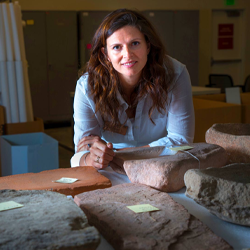Holocene vegetation and climate change on the Colorado Plateau in southern Utah, USA
 Authors:
Authors:
Lisbeth A Louderback, Christopher A Kiahtipes, Joel C Janetski
Abstract:
Pollen, plant macrofossils, and sedimentary analyses from archaeological deposits at North Creek Shelter (NCS) on the Colorado Plateau provide data on vegetation and climate change during the Holocene. From 11,300–10,200 cal yr BP, NCS was embedded in a mixed conifer forest of cool-adapted species (e.g., Abies, Pseudotsuga menziesii, and Pinus ponderosa) with an Artemisia understory. During this interval, NCS pollen corresponds to modern pollen from Picea– Abies forests that reside 950 m higher in elevation. Rapid deposition rates of NCS sediments indicate that climatic conditions during the Early Holocene were more mesic than today, with increased precipitation. The onset of warmer conditions at NCS began at 10,200 cal yr BP, and pollen and plant macrofossils indicate that a semiarid woodland and scrub mosaic dominated by Pinus edulis, Juniperus osteosperma, and Amaranthaceae surrounded NCS by 9300 cal yr BP. This is corroborated by fossil pollen that is similar to modern pollen from P. edulis–J. osteosperma woodlands and Amaranthaceae scrub that currently surround NCS. Sedimentary analyses suggest that during this time, accumulation rates were very low due to low precipitation and a drier climate overall. Migration of P. edulis into southern Utah is directly dated to 8100 cal yr BP, thus confirming recently proposed patterns of northward expansion.
View this publication here
